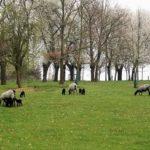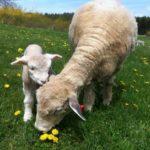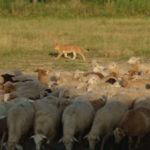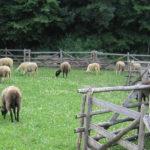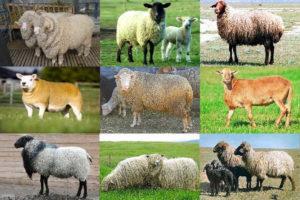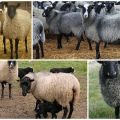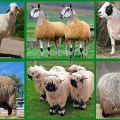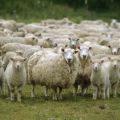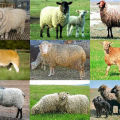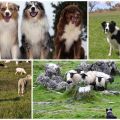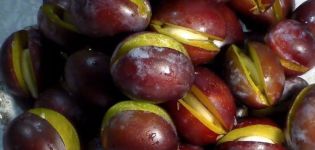Rules and norms for grazing sheep per hectare, how much grass is eaten per hour
Pasture grazing is an economical way to feed sheep. Natural herbs are rich in vitamins and minerals. Free-range animals are more fertile, gain weight faster and produce healthy offspring. Modern sheep breeding includes seasonal selection of the area, calculation of grass consumption rates and the number of heads per hectare. Despite the difficulties with calculations, keeping and grazing sheep in the pasture is beneficial for farmers and good for the health of consumers.
Pros of pasture maintenance
Benefits of grazing sheep in pasture:
- freedom of movement and communication of animals;
- natural free food;
- saving time for cleaning in stalls.
Milk and meat of animals that grazed in nature are valued higher and are considered environmentally friendly.
Terms and organization of pasture use
How to use the pasture rationally:
- analyze the yield of herbs;
- calculate the timing of eating plants by animals;
- determine the permissible number of individuals per hectare of area.
The time of use of the pasture is limited by the maturation and restoration of the grass cover. To prevent the animals from trampling the grass too quickly, the territory is divided into squares and portable fences are installed. When the sheep eat the grass in one area, the partitions are rearranged to the next square and the animals are transferred there. The grass cover is restored within a month. Therefore, the flock is allowed to enter the first section not earlier than this period. The area of the plots is calculated so that the herd has enough food for a week.

Where is the best place to graze sheep?
When choosing a pasture, the type of terrain is taken into account. Various herbs grow in the mountains and steppe. The path to grazing also matters.
Natural pastures
In different seasons, the herd is taken to a meadow or mountains. But the shepherd must carefully inspect the area, since among the useful herbs there is feather grass, which is harmful to rams. The stems and leaves of the plant injure the mucous membrane of the mouth of animals, and the seeds cling to wool, pierce the skin and cause feather grass disease.
Steppe
The most common type of pasture is steppe.
In summer, the grasses burn out, and the nutritional value of the pasture decreases.
Mountain
Grazing on the slopes of the mountains has a beneficial effect on the quality of sheep meat, wool and milk.
Alpine and subalpine pastures are the most valuable in the world.
Dry
River watershed pastures are among the best natural grazing areas.
Natural dry pastures are highly valued as they have almost no disadvantages.
Forest
A type of pasture that is not very suitable for grazing is forests.
Light forests with partial shade and wooded mountain slopes are suitable for grazing.
Swampy
Sheep are not grazed constantly in areas with high soil moisture.
On the marshland, cinquefoil, sedge, moss, and reed grow - plants that sheep do not like.
Wet meadows
A good time for grazing in a flooded meadow is early spring and late autumn, after the aftermath has been mowed.
Buttercups and horsetail are found among the dense grass of the water meadow. All plants of the Buttercup family contain toxic substances that irritate the respiratory tract of sheep. Horsetail in large quantities is harmful to cat sheep, as it can cause premature birth.
Artificial pastures
The volume of eaten mass of plants on artificial pastures reaches 95 percent.
Grazing rules
The animals are gradually transferred from the stables to grazing in the pasture.
Training
The abrupt transition from winter to grazing in the stable causes digestive upset in sheep. Therefore, the flock is prepared according to the following rules:
- let out to graze for an hour in the afternoon;
- feed with hay before grazing;
- upon returning to the stable, they drink abundantly.
General preparation rules:
- conduct a veterinary examination of animals, vaccination against ticks, parasites and infections;
- trim the hair on the hooves and around the eyes;
- divide the flock into flocks according to age and wool quality.

The pasture is preliminarily examined, places for rest and grazing are outlined, and a schedule for driving is drawn up.
Schedule
Sheep are released to pasture in late spring - in mid or late May, depending on the climate. At the beginning of the month, the grass is still not high enough and nutritious.
Grazing begins at dawn. Sample schedule:
| Time | Act | Description |
| 05:00 | Otaru is driven to the pasture | It is not hot early in the morning and there are no blood-sucking insects. |
| 11:00-12:00 | Sheep are driven into the shade, to the river for an afternoon rest | Day distillation starts earlier on especially hot days. If the weather is cool, cloudy, the flock is not overtaken or grazed until noon |
| 15:00 | The herd is taken to the pasture | The heat is on the wane |
| 20:00-21:00 | Otaru are being taken home | In summer, the herd can stay in the meadow longer |
During spring grazing, the sheep are driven to the legume area after the morning dew subsides and before the evening dew falls. Young moist stems ferment in the stomach of animals, and tympanum disease develops as a result.
Features of summer grazing:
- early fit due to dew;
- transition to the shade for chewing grass;
- night grazing.
The animals are brought to the field at 18:00. They feed until one in the morning, rest for two hours and feed again until ten or eleven in the morning. During the day, the herd rests in the sheepfold. In summer, dew softens the cereals and helps them better digest them. But do not graze the flock on wet alfalfa.

During winter grazing, the herd is released to pasture at 11 am. Covered parking areas with a supply of hay and water will be equipped on the territory. In case of bad weather, the animals are herded under shelters. In sheep breeding, grazing methods are used without a shepherd. The animals are kept in open pens, through the fences of which the current is conducted. Low voltage is safe for ram, sheep and lamb, but will keep the flock from scattering around the area.
Organization of a watering hole
In summer, thirst is more difficult for sheep than hunger. On hot days, animals are watered three times a day. In autumn, the number of visits to the watering hole is reduced to two times. On especially cool days, the sheep are watered once a day.
The maximum distance that a herd can travel is 3 kilometers. If the reservoir is further away, water is brought to the pasture. Sheep who travel long distances every day gain less weight.
Tips & Tricks
How to start grazing sheep:
- during the first grazing, do not often drive from one place to another, so as not to disturb;
- young growth and pedigree producers are brought to the best lands;
- graze in a deployed formation so as not to trample the site;
- when choosing an area, give preference to lands with a high content of white clover and timothy.

In summer, parking areas should be changed every 12 days to reduce the likelihood of infestation by worms and parasitic blowflies;
What difficulties may arise
Before starting grazing, you need to know that:
- spring grass contains a lot of potassium. Sheep suffer from seizures from excess substance. The excess potassium is balanced with sodium, which is contained in salt. The daily rate for an adult animal in the spring is 10 grams;
- hatching on alfalfa alternates with feeding on natural pasture. The stems of the plant are covered in the stomach with common herbs and are better absorbed;
- not every clover is good for sheep. The plant with red flowers in the first year of growth contains nerve poison. In a field with red clover, sheep are allowed after the aftermath is removed in the second year;
- the sheep gather tightly and warm one another. Herding instinct is useful in winter, but dangerous in summer. Animals need to be separated to avoid heatstroke.
The health and nutritional status of the sheep depends on the skill of the shepherd. An experienced shepherd understands useful and harmful herbs, determines the duration of grazing by the weather.

Sheep grazing rate per hectare
The rate of grass consumption depends on the type of pasture and the number of sheep.
To calculate how many heads should graze on one hectare of field, use the following formula:
G = U / N x P
Formula variables mean:
- Г - the number of sheep;
- Y is the yield per hectare multiplied by the percentage of pasture use;
- H - the amount of green mass that sheep eat for grazing;
- P is the period of use of the pasture.
Natural lands are used by 60 percent, and artificial - by 90. Grazing lasts 6 hours, excluding midday rest. One sheep eats 2 kilograms of greens per hour or 12 kilograms per day on grazing.
Can you fall in the rain?
Animals suffer from digestive upset from wet grass. Food swells in the rumen, the first of the four stomachs. Gas and foam will block belching.
Ruminants first collect the grass in a rumen, and then regurgitate and chew it.Without belching, food wanders in the stomach for a long time, causing bloating and shortness of breath. In a neglected state, animals die from suffocation. Therefore, sheep should not be grazed in the rain, immediately after the shower and in the dew.










